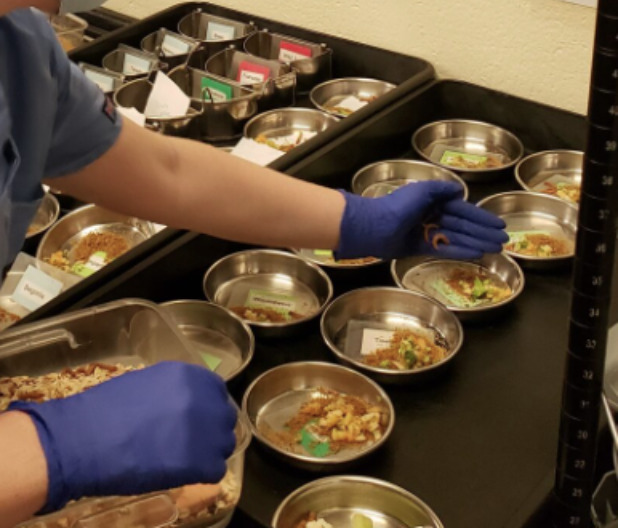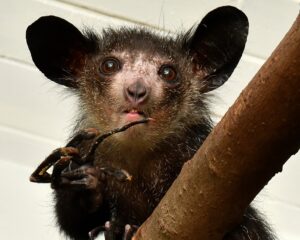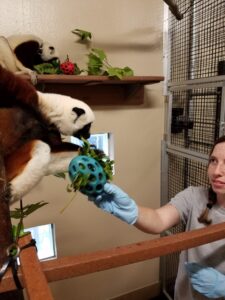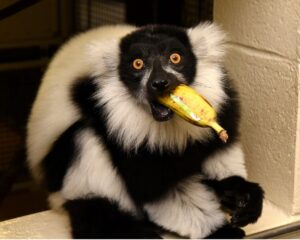Eating Like A Lemur
Keeping the Duke Lemur Center’s population of over 200 diverse lemurs fed is a big job. Diet preparation starts at 6:30 AM so the lemurs can get their breakfast in a timely manner, and over 20 pounds of produce and 20 pounds of lemur chow are chopped, portioned, and prepared according to each animal’s dietary needs every day. Even more challenging than the kitchen work is the time, effort, and experimentation required to ensure each lemur species is getting the right foods in the proper amounts. Good food is the foundation for the health and happiness of the animals in our care. While the Duke Lemur Center was founded in 1966, we are still learning and tweaking our menus more than 55 years later.

Small nocturnal lemurs get about a tablespoon of food per day, plus worms.
With over 100 identified lemur species living on the large island of Madagascar, diets are going to look different both from one habitat to another and from one species to another. Lemurs are experts at niche specialization, meaning that they adapt to a particular role in the ecosystem to avoid competition from other species. Most lemur species can be classified as opportunistic omnivores, meaning that they will eat a wide variety of foods and take advantage of easy food resources when possible. However, different species of lemur can have highly specific dietary needs as a result of evolution to a particular niche.
Sifakas tend to be folivores, leaf-eating specialists that require high levels of fiber in their diet. The Coquerel’s sifaka eats over 100 different leaf species and has a long intestinal tract that allows time for these tough leaves to break down in their gut and provide them with the nutrients they need. Ring-tailed lemurs, on the other hand, are true omnivores, and are some of the only lemur species that will hunt and eat small vertebrates like lizards in addition to foraging for fruit, leaves, flowers, and insects Ring-tailed lemurs would not be able to thrive on a diet of only leaves, and sifakas would not be able to digest many of the food items that ring-tailed lemurs consume daily.

Coquerel’s sifaka lemurs are folivores, meaning that they primarily eat leaves.
But it doesn’t always come down to the gut—some lemurs just have the right tools for the trade. Aye-ayes are percussive foragers that feed on insects and larvae living inside tree trunks. Their powerful teeth and flexible fingers allow them to extract these hidden snacks from the wood where other animals can’t get to them, giving aye-ayes an advantage. Recreating the dietary needs for such a wide range of specializations is a challenge outside of the wilds of Madagascar.

Aye-ayes use their flexible tapping finger to find and extract insects from trees.
While the natural habitats of lemurs can’t be fully imitated in human care outside of Madagascar, keepers can provide food items that both meet the lemurs’ nutritional needs and allow them to use their natural foraging skills. Each lemur gets an individualized diet based on the animal’s species, age, weight, personal preferences, and overall health. How much of certain foods a lemur gets might change if they put on a little weight or lose a little weight, or if they have a life change like giving birth to offspring. Geriatric lemurs might be provided softer foods or might have their crunchier vegetables cooked if their teeth aren’t as strong anymore.
In general, most lemurs at the DLC are fed a rotating combination of fruits and/or vegetables and primate chow, a specially-made biscuit for primates. There are three different types of primate chow with varying levels of nutrients, intended for leaf-eaters, fruit-eaters, or omnivores. Some lemurs will get fruit every day, while others will only get fruit rarely. Small nocturnal lemurs like dwarf lemurs and mouse lemurs are fed mealworms or wax worms along with their produce and chow. Aye-ayes will receive their worms inside of blocks of wood or other hard feeders that require them to use their natural percussive foraging skills. As often as possible, all of the lemurs get their diets fed to them in ways that require them to “work” and use their natural behaviors.

Lemur keepers at the DLC give the animals enrichment at least twice per day.
With ongoing research both in Madagascar and at the DLC, we are constantly learning new things about how and what lemurs eat. The DLC Museum of Natural History studies extinct lemurs, so they can look at fossil or subfossil lemur teeth to get clues about what lemur ancestors ate. Researchers like Dr. Lydia Greene study the gut microbiome of certain species by taking samples of their feces and looking at them under a microscope. Studies like these help us ensure that the lemurs’ digestive tracts are healthy and have all the right bacteria in them. Dr. Marina Blanco studies hibernation in dwarf lemurs, which has a lot to do with their metabolism and fat storage, which are both affected by their diet. Guest researchers have also come to study things about lemurs’ relationship to food, such as taste preference and bite size. All of this ongoing research is non-invasive for the animals, and helps us to not only improve the way we feed lemurs here at the Duke Lemur Center, but also helps us learn how to keep these endangered primates happy and healthy in the wild for many years to come.

One research study looked into how large of a bite a lemur will take when eating. Some bites were very large.

